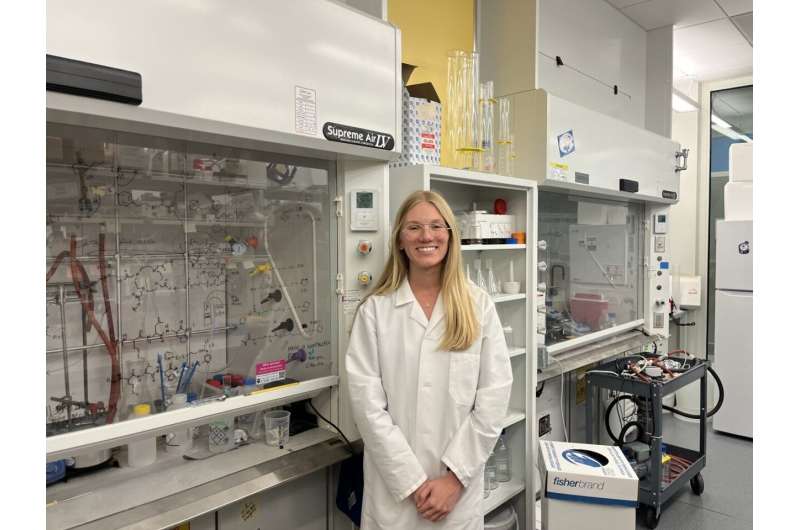
Acute myeloid leukemia (AML) is a type of blood cancer that forms in the soft marrow of the bones, typically attacking cells that would otherwise form the key component of the body’s immunodefense system, white blood cells.
In a new study published in Blood Advances, researchers from the UChicago Pritzker School of Molecular Engineering’s Hubbell Lab created with a novel approach to develop in-situ cancer vaccines that could increase the effectiveness of immunotherapies in AML and other blood cancers.
“We are trying to come up with cancer vaccine approaches that could be more easily scaled and applied, in other words, one type of vaccine that works with a number of cancers,” said Prof. Jeffrey Hubbell, the Eugene Bell Professor in Tissue Engineering at PME.
Powerful protection against pathogen attacks
Vaccination is a well-known method to prevent diseases caused by a variety of pathogens like bacteria and viruses. It works by exposing a small part of the pathogen—usually a protein—to the immune system so that immune cells are primed to fight off incoming pathogens.
Our immune system not only safeguards us from pathogen attacks but also protects against any abnormal changes happening within the body. For example, immune cells can identify abnormal mutated proteins or cancer cells and eliminate them from the system. Thus, cancer vaccination has emerged as a powerful tool to harness the immune system to treat cancers.
Some vaccines work by preventing specific cancers from developing, such as the human papilloma virus (HPV) vaccine that protects against a virus that can cause cervical cancer. Other vaccines are therapeutic vaccines, meaning to prime immunity to attack existing cancers. This new research falls into the latter category.
From an immune perspective, cancer can often appear exactly like healthy tissue, so the immune system does not always initiate a response against it unprompted, said Pritzker Molecular Engineering doctoral candidate Anna Slezak, the first author of the paper.
Slezak, who is also a trainee associate member of the University of Chicago Medicine Comprehensive Cancer Center, is trying to identify key differences in cancer cells so those unique attributes can be targeted to drive a specific immunological response against the cancer cells as opposed to healthy tissues.
Immune cell targets, or antigens, are usually the mutated proteins of the cancer cells. For many years, scientists have been sequencing tumor biopsy samples to identify target proteins that can be used to develop vaccines. This knowledge-based approach can be very useful in making personalized vaccines, but it becomes a laborious process.
Exploiting unique features of cancer cells
Recently, Hubbell’s team leveraged a unique feature of cancer cells to develop a generalized cancer vaccine. Tumor cells, unlike healthy cells, have unpaired cysteine molecules on their surfaces as a result of metabolic and enzymatic dysregulation. These unpaired cysteines provide a tumor cell-enriched chemical feature that can be exploited to target their material specifically to the cancer cells.
Attaching an adjuvant, usually a drug or chemical substance, to the material that tags free thiols can enhance the immune response and turn the tumor cell itself into the vaccine, simply by injecting the material into the blood.
“Our material binds specifically to these free thiols and can covalently link our adjuvant to the tumor cell, tumor debris, whatever the thiol is attached to,” Slezak said. This is a way to tag cancer cells or debris of dying cancer cells in the circulating blood for immune recognition and trigger immunity to their mutated proteins.
The construct also contains mannose, a type of sugar group, and a Toll-like receptor-7 (TLR-7) agonist. The mannose groups help traffic the debris to antigen-presenting cells (APCs) residing in the liver and spleen, and TLR-7 is required for immune system activation. Once APCs engulf the construct, it triggers TLR-7-mediated immune response against the debris or cancer cells.
Chemotherapy enhances the cancer vaccine effects
To generate a more effective response, the researchers combined vaccine delivery with cytarabine treatment, a chemotherapy commonly administered in AML patients.
“Combination therapies are hard to develop, but they tend to be more effective than monotherapies,” Hubbell said.
In this study, the combination treatment with low-dose cytarabine significantly increased the survival rate after intravenous administration of the vaccine. As this vaccine approach does not target any specific cancer protein, the study authors said it may have applicability in other hematological malignancies.
“People have tried this concept before with using antibodies to target the tumor cell rather than the polymer, like an antibody-drug conjugate or an antibody-adjuvant conjugate,” Hubbell said. “But here we are coming up with an approach that does not require a targeting antibody. That’s a big advantage over what’s been tried before in this tumor cell-targeted adjuvant concept.”
Future work of the Hubbell lab will focus on the chemistry of novel vaccines, particularly asking questions about what kind of an immune adjuvant or other molecules can be attached to the material that tags cancer cells to yield exciting outcomes in cancer treatments. The rearchers note that there is much more preclinical work that is necessary before the approach would be ready for clinical testing.
More information:
Anna J. Slezak et al, Cysteine-binding adjuvant enhances survival and promotes immune function in a murine model of acute myeloid leukemia, Blood Advances (2024). DOI: 10.1182/bloodadvances.2023012529
Citation:
New approach for developing cancer vaccines could make immunotherapies more effective in acute myeloid leukemia (2024, May 3)
retrieved 3 May 2024
from https://medicalxpress.com/news/2024-05-approach-cancer-vaccines-immunotherapies-effective.html
This document is subject to copyright. Apart from any fair dealing for the purpose of private study or research, no
part may be reproduced without the written permission. The content is provided for information purposes only.


